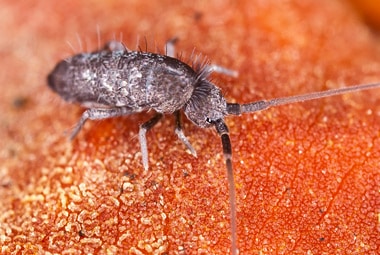
Springtails are nuisance pests that are attracted to and live in areas of high moisture. They are found throughout the United States including here in Missouri. Springtails are named for the way they “jump” as a means of movement using a specialized appendage.
| Pest Identification | |
|---|---|
| Recognition | The springtail’s most distinctive characteristic is the tail-like appendage (furcular) that is located underneath their abdomen. When the springtail releases the furcular, it sends them through the air and out of the way of harm very quickly. Adult springtails are very small and grow only to between 1/32 and 1/8th of an inch in length. They are wingless, have poor vision, and are soft bodied. They come in a variety of colors including orange, yellow, purple, gray, and blue; but to the human eye they just look grayish black in color. |
| Biology | Springtails “breathe” through their body covering; they also absorb water the same way. Because of this, springtails need a constant source of moisture to prevent them from drying out. It is not uncommon to witness thousands to millions of springtails emerging from the ground when it becomes too dry or too saturated after a large amount of rain. Female springtails lay their eggs in moist areas like in soil or underneath mulch, grass, or leaf piles. When the larvae hatch, they will molt up to 10 times before maturing into an adult. This process generally takes 2-3 months, but depending on the environmental conditions, it can sometime take up to 2 years to complete. Once the springtails have matured into adults, they will continue to molt throughout their lifetime. |
| Habits | Springtails are generally found outdoors living in moist soil; however, if their environment becomes too dry, they will migrate in search of moisture. Sometimes they find their way underneath doors and windows into homes or businesses. Once inside, they can become a nuisance and are difficult to find and completely eliminate. When they remain outside, springtails are environmentally beneficial. They feed on things like decaying vegetation, fungi, bacteria, pollen, and insect feces. As they feed and break down their food sources they release important nutrients back into the soil helping to keep it healthy. Springtails are active year round. In fact, some species can be seen jumping across the snow and are referred to as “snow fleas”. |
| Prevention | The best way to prevent problems with springtails in your home is to make sure that any cracks and crevices found in your home’s foundation and exterior walls are sealed and that gaps found around windows and doors are calked. It is also important to make sure that door sweeps are installed on all exterior doors. Because springtails are so small, stopping them from entering your home can be difficult. The best way to prevent problems with them is to have a year-round pest control plan in place. |
| Professional | Rottler Lawn & Pest Solutions can provide safe and effective services to get rid of springtails with our home pest control services. Our expertly trained technicians will inspect your home and property in order to find all the areas where they are hiding and breeding. By implementing year-round services, you can be sure that any current problems with springtails will be handled and future problems will be prevented. |

